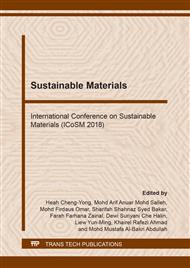p.231
p.237
p.243
p.251
p.258
p.264
p.270
p.277
p.284
Mechanical Properties and Morphology of Epoxy/Graphene Nanocomposite Using Bath Sonication and Tip Sonication
Abstract:
There are different graphene loadings (0, 0.2, 0.4, 0.6, 0.8, and 1.0 vol%) were used in order to study the effect graphene loading using different type of ultrasonication. Two types of ultrasonication: bath and tip sonication were applied in the preparation of epoxy/graphene nanocomposites. Effect of different ultrasonication applied on the mechanical properties and morphology of nanocomposites were investigated. By using tip sonication, epoxy/graphene shown better improvement in the mechanical properties due to direct ultrasonication that generates higher sound pressures and intensity compared to bath sonication which is indirect ultrasonication. Besides, epoxy/graphene nanocomposites prepared using tip sonication exhibits greater fracture toughness where lower intensity and non-uniform sonication effect failed to achieve optimum dispersion of graphene nanoplatelets and also its distribution using bath sonication. Rougher surface with increased deflected crack lines was observed on the samples that prepared using tip sonication further proven that more fracture energy was dissipated which inhibits the propagation of cracks and hence delayed the failure of nanocomposites.
Info:
Periodical:
Pages:
258-263
Citation:
Online since:
August 2018
Authors:
Price:
Сopyright:
© 2018 Trans Tech Publications Ltd. All Rights Reserved
Share:
Citation:


